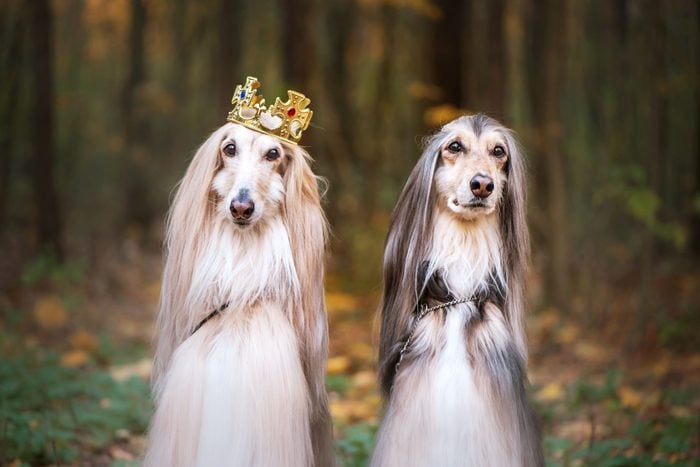
High-priced pups
Any dog will cost you some kibble. Owning a pup has its costs—vet care, food, toys, treats, grooming, boarding and dog-walking fees. Of course, there’s also the initial cost of purchasing the dog too, which is the criteria we used for this list of the most expensive dog breeds. There aren’t set-in-stone prices for dog breeds, so we pawed through puppy listings across the country and turned to Gooddog.com (a website to find healthy, vet-checked puppies and dogs from trusted breeders and shelters) to come up with an average cost.
Several factors influence the higher price tag, says Jaclyn Coble, DVM, veterinarian at Sea Legs Integrative Veterinary Health in West Roxbury, Massachusetts. Whether you’re choosing one of the most popular dog breeds or something rarer, the dog’s overall popularity, pedigree and rarity in your location will dictate the price. “For example, Pharaoh hounds, similar to Tibetan mastiffs, are expensive because of their relative rarity in the United States,” says Dr. Coble.
Whatever the reason, these breeds fetch a higher price tag—and dog lovers will say they’re worth every penny! We spoke to expert veterinarians, including Dr. Coble and Deepan Kishore, DVM, to get the scoop on these pricey pooches. Ahead, we’ve rounded up the most expensive dog breeds that money can buy.
Get Reader’s Digest’s Read Up newsletter for more pet insights, cleaning, humor, travel, tech and fun facts all week long.
About the experts
Reviewed for accuracy by: Caroline Coile, PhD, an award-winning journalist specializing in canine breeds, health and science. She’s the author of 34 books, including Barron’s Encyclopedia of Dog Breeds. |
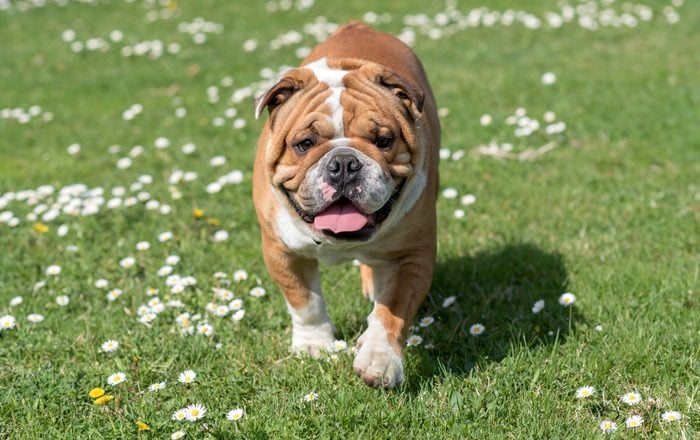
1. English bulldog
Average cost: $4,250
When the National Dog Show hosts share their most interesting moments, they always mention a bulldog named Thor. Viewers and spectators fell in love with this adorable flat-faced dog breed and its confident and charming swagger. He impressed the judges too and took home the Best in Show honors in 2019. When certain dogs win, it often propels the breed into instant popularity and makes them one of the most expensive dog breeds to own. Show dog or not, the English bulldog has a lot going for it, especially if you love a low-key dog with a cute brawny frame and an adorably wrinkled face.
| Breed overview | |
| Height: | 14 to 15 inches |
| Weight: | 40 to 50 pounds |
| Life expectancy: | 8 to 10 years |
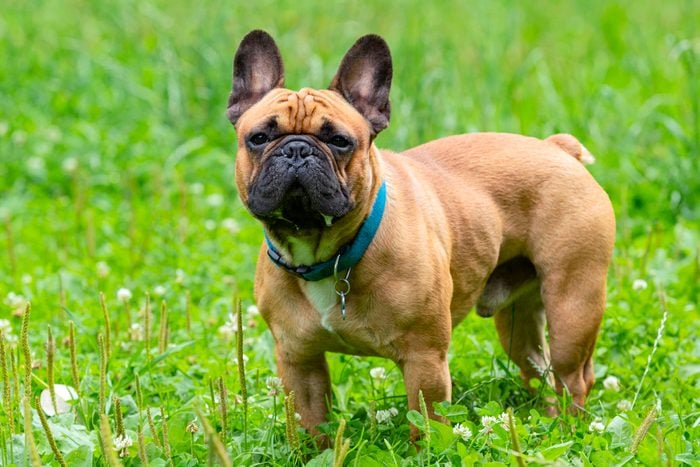
2. French bulldog
Average cost: $4,250
If you’re looking for an adorable short-legged dog, this fun-loving, short-haired dog breed could be the pup of your dreams—if you’re willing to shell out the dough. You won’t have to make regular trips to the groomer, so that may save you some money in the long run, but those irresistible wrinkles do merit daily attention and should be kept clean and dry.
Speaking of attention, the Frenchie demands lots of doting, playtime and general interaction from its human family. As a matter of fact, that’s probably why they love kids so much—instant playmates! Unless they get excited, Frenchies probably won’t be loud or rambunctious barkers, but they are known for their preciously sweet snorts and snores.
| Breed overview | |
| Height: | 11 to 13 inches |
| Weight: | Under 28 pounds |
| Life expectancy: | 10 to 12 years |

3. Tibetan mastiff
Average cost: $4,000
If the price of a dog were based on weight, pound for pound, the Tibetan Mastiff would be a front-runner for sure. Case in point, a red Tibetan mastiff named Big Splash is the most expensive dog ever sold. His new owner shelled out $1.5 million to take home a then 11-month-old, 180-pound puppy.
The Tibetan mastiff’s size could undoubtedly be intimidating, but this breed is actually a very affectionate family dog breed, albeit a bit standoffish and territorial with strangers. What is intimidating are the other expenses. “They require extensive grooming to keep their coat shiny and healthy,” says Dr. Coble. “Also, because medication doses are based on weight, be prepared for high veterinary bills.”
| Breed overview | |
| Height: | 24 to 26 inches |
| Weight: | 70 to 150 pounds |
| Life expectancy: | 10 to 12 years |
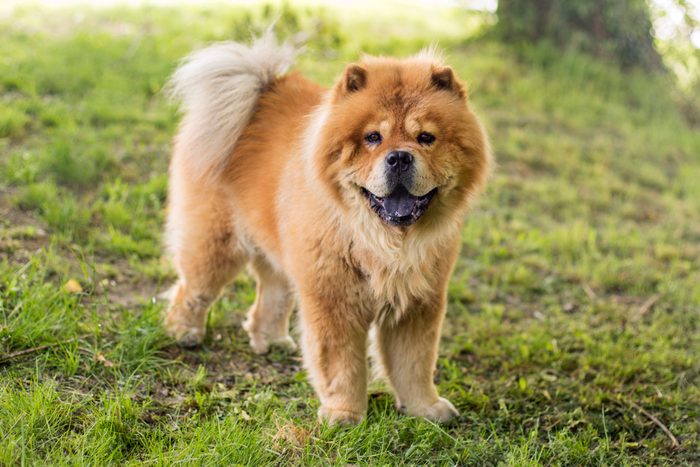
4. Chow chow
Average cost: $4,000
With an enormous fluffy face, this authentic Chinese dog breed has a lot of unique features befitting an expensive dog breed, including a cool, dark blue-purple tongue. Then there’s the famous scowling expression it sometimes wears, even when it’s happy. Strong-willed, independent and often aloof, the chow chow’s vibe is similar to that of a cat. It is endearing and perplexing at once. Fastidious like cats, chow chows don’t have offensive doggy odors when they are brushed often.
| Breed overview | |
| Height: | 17 to 20 inches |
| Weight: | 45 to 70 pounds |
| Life expectancy: | 8 to 12 years |
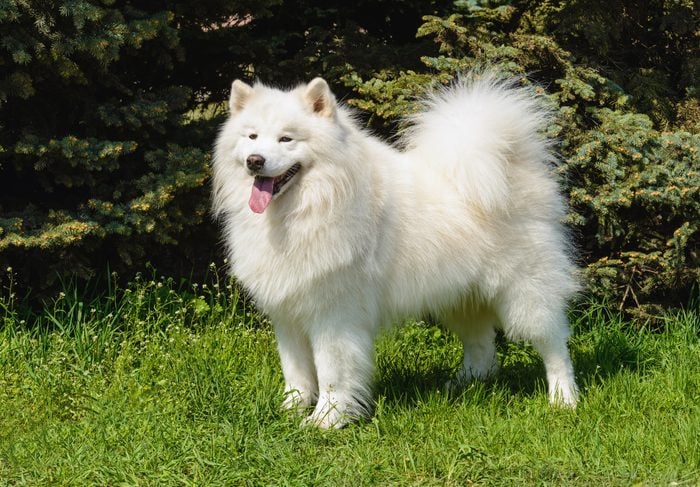
5. Samoyed
Average cost: $3,750
Famously known for its cheerful, contagious smile, this adorable and fluffy Russian dog is one of the most expensive dog breeds. Besides melting our hearts, that smile has a practical purpose. The upturned corners of the lips keep the dogs from drooling, which also prevents icicles from forming on their faces. But there are some health issues pet parents should know.
“Samoyeds can also come with some expensive veterinary bills,” says Dr. Coble. “They are prone to hereditary eye problems and hip dysplasia.” That said, they are lovey-dovey and gentle with humans of all ages. They do get bored easily, though, so they’ll fit best with people who have time to provide ample exercise and loads of mental stimulation.
| Breed overview | |
| Height: | 19 to 23.5 inches |
| Weight: | 35 to 65 pounds |
| Life expectancy: | 12 to 14 years |
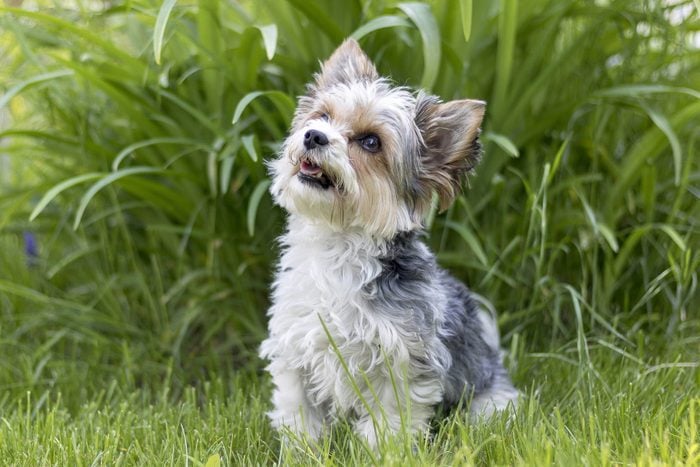
6. Biewer terrier
Average cost: $3,500
Although it bears no resemblance to the beaver, Biewer is pronounced “beaver.” They were named for the original breeders, Gertrude and Werner Biewer. You’re not mistaken if you think they look exactly like another dog breed. “Genetic testing has shown a mixed gene pool comprising Yorkshire terriers, Maltese, Havanese and Bichon Frise,” says Deepan Kishore, DVM, is a veterinarian at Neel Veterinary Hospital in Oklahoma City.
As one of the newer breeds recognized by the American Kennel Club (AKC), their popularity and price tag have been growing. Bred to be great companions and lap-loving dogs, these little darlings are as sweet as they look. Standing under a foot tall and just 4 to 8 pounds, they are portable and fun little sidekicks that win hearts everywhere they go.
| Breed overview | |
| Height: | 7 to 11 inches |
| Weight: | 4 to 8 pounds |
| Life expectancy: | 16 years |
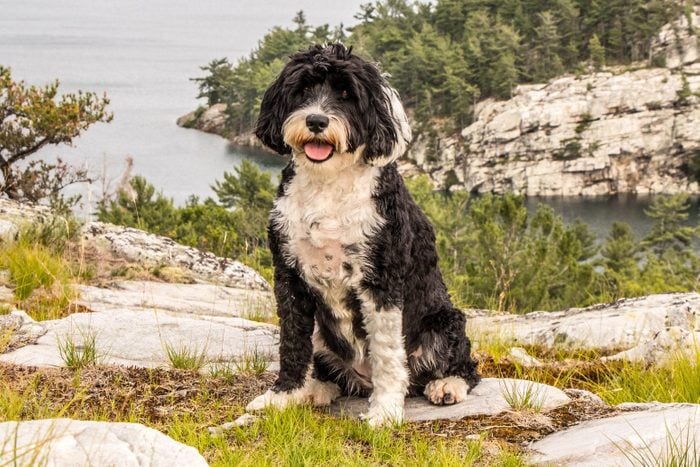
7. Portuguese water dog
Average cost: $3,500
It’s hard to resist an adorable curly haired dog that doesn’t shed much. Maybe those perks are how two Portuguese water dogs found their way to the White House. President Obama had two of them: Sunny and Bo.
While those tight-woven curls don’t end up all over your furniture, they do need frequent brushing to keep tangles from forming and full-coat trims monthly. Temperament wise, Portuguese water dogs are friendly, affectionate, smart and adventurous. Activities that utilize their intellect and need for physical exercise will keep these cuties happy and fit.
| Breed overview | |
| Height: | 17 to 23 inches |
| Weight: | 35 to 60 pounds |
| Life expectancy: | 11 to 13 years |

8. Greater Swiss mountain dog
Average cost: $3,450
The Rottweiler and Saint Bernard can thank their Great Swiss mountain dog (aka Swissy) ancestors for helping to develop their breeds. You can see the similarity in their rugged good looks and strong, muscular physiques. Plus, they all share the status of being some of the most expensive dog breeds.
Though Swissys are a working breed, they tend to gel with the activity level of their family. That doesn’t mean exercise should take a backseat when it comes to keeping the Swissy in prime condition though. Working dogs flourish when they have “jobs” to do, be it pulling a cart in the garden, hiking or backpacking. Just be sure your Swissy stays cool, as this faithful and family-geared dog doesn’t fare well in hot climates.
| Breed overview | |
| Height: | 23 to 28.5 inches |
| Weight: | 85 to 140 pounds |
| Life expectancy: | 8 to 11 years |
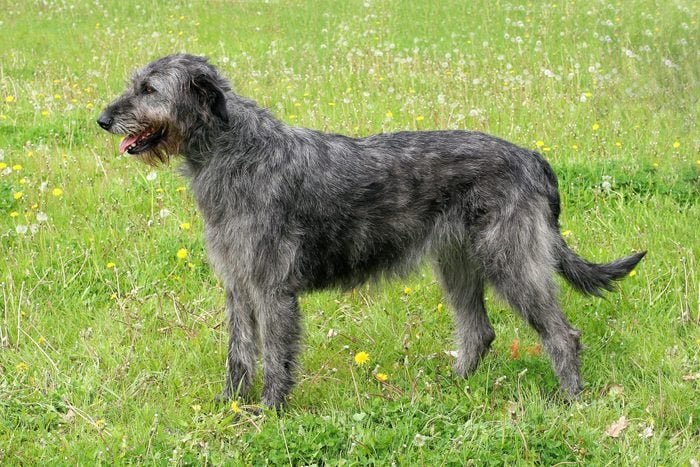
9. Irish wolfhound
Average cost: $3,250
Wire-haired dogs may not scream “soft and cuddly,” but these gentle giants are an expensive dog breed that’s uber sensitive and sweet. They also happen to be one of the tallest and heaviest breeds of the sighthounds, a family of dogs that depends on their eyes more than their snouts for hunting. They are an impressive 32 inches at the shoulder and weigh around 120 pounds. Because they are so large, it can take more money to breed them.
But as formidable as they look, they fail as guard dogs. They’re not suspicious or remotely aggressive. On the contrary, they are easygoing, patient and sweet. The breed is relaxed with other pets and dogs in the house and good with children.
| Breed overview | |
| Height: | 30 to 32 inches |
| Weight: | 105 to 120 pounds |
| Life expectancy: | 6 to 8 years |
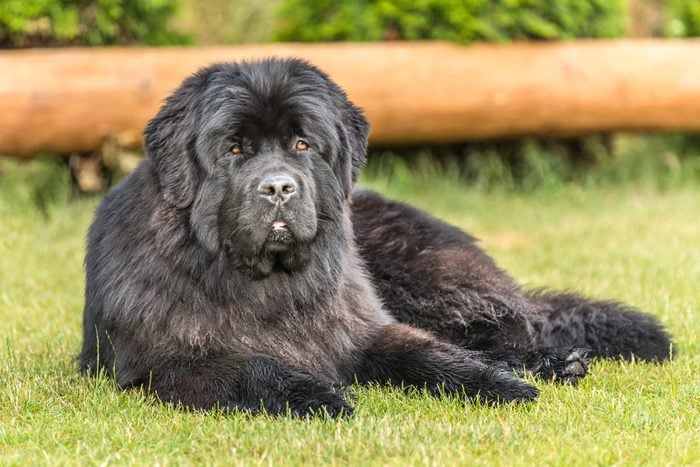
10. Newfoundland
Average cost: $3,250
The Newfie retains gold-medal status for being one of the most easy-going and low-key dogs on the planet. They’re not likely to bite and are exceptionally gentle, patient and watchful with young children. On top of that, they are notably friendly and enjoy the company of other dogs too. Newfies aren’t looking for high-intensity exercise—a daily leisurely walk should fend off boredom and help keep them fit.
As a bonus, Newfies don’t do much shedding or drooling—something to keep in mind if you’re not a fan of weekly brushing, vacuuming or puddles.
| Breed overview | |
| Height: | 26 to 28 inches |
| Weight: | 100 to 150 pounds |
| Life expectancy: | 9 to 10 years |
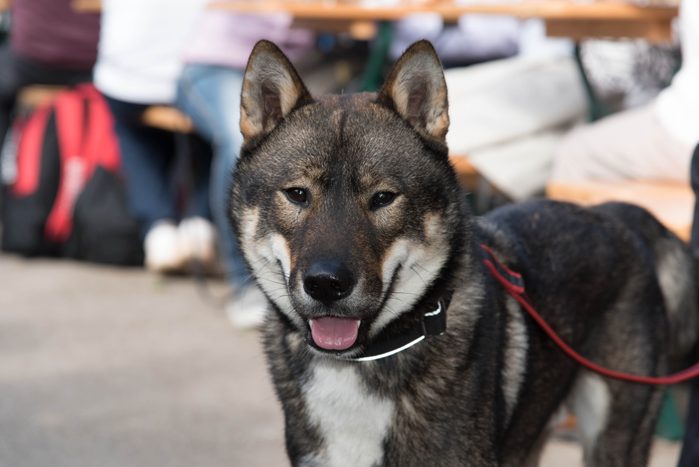
11. Shikoku
Average cost: $3,250
The price tag of expensive dog breeds often coincides with newfound popularity in the media. The fantastical over-sized dire wolves in Game of Thrones and the beloved dog Rollo in Outlander launched a desire to adopt or buy dogs that look like wolves. The Shikoku, also known as the Kochi-ken (ken means dog), looks like a wolf and is named for an island in Japan.
It’s an alert and enthusiastic dog with loads of endurance, probably stemming from its ancestors, who were tireless boar hunters. They’re tenacious, have a high prey drive and have a strong connection to nature, preferring snow and colder climates, Dr. Coble says. Indoor time is focused on their humans. “They are loving and loyal to their family,” says Dr. Coble.
| Breed overview | |
| Height: | 17 to 22 inches |
| Weight: | 35 to 55 pounds |
| Life expectancy: | 10 to 12 years |
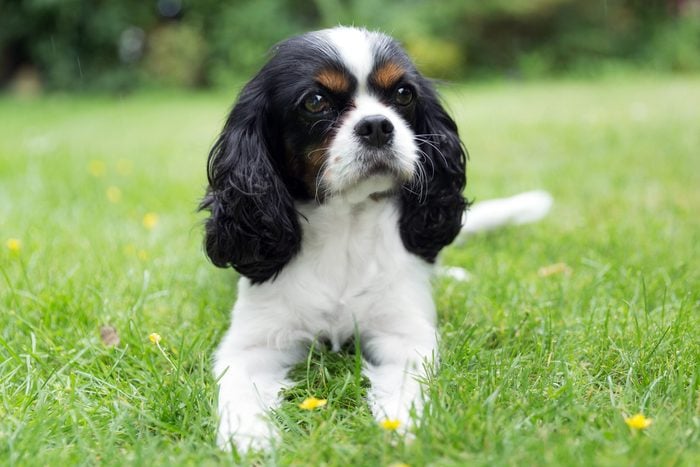
12. Cavalier King Charles spaniel
Average cost: $3,000
Undeniably one of the cutest dogs you’ll ever meet, the Cavaliers have so much more than melt-your-heart good looks going for them. They also have comfort-bestowing superpowers and are sensitive to what humans need, be it a snuggle session to soothe anxiety or a cheerful distraction with their playfulness. They easily check off the qualifications for some of the best dog breeds for emotional support and the most beloved family dogs.
But their generous hearts are prone to developing mitral valve disease at much younger ages. “Due to the heritability of these conditions, it is important to go through a reputable breeder when making your purchase,” says Dr. Coble. “Make sure you have money set aside for veterinary bills, or even better, get pet insurance.”
| Breed overview | |
| Height: | 12 to 13 inches |
| Weight: | 13 to 18 pounds |
| Life expectancy: | 12 to 15 years |
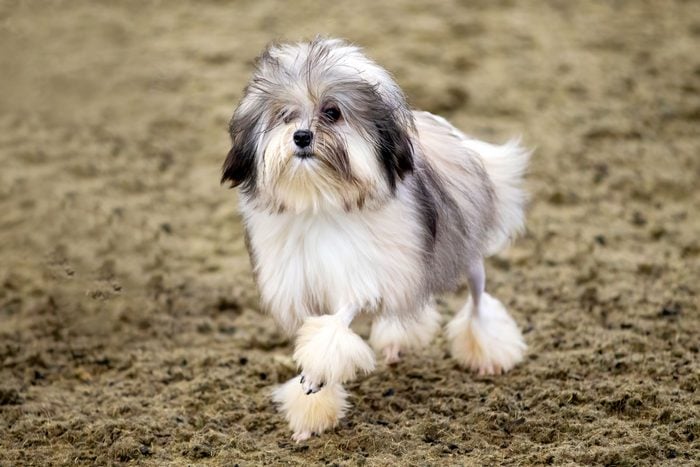
13. Löwchen
Average cost: $3,000
Flowy manes make some dogs look like lions, but the Löwchen (pronounced lerv-chun) has a name that actually means “little lion dog” in German—with emphasis on “little.” While their price tag is large, these pups only weigh around 15 pounds and stand just over 1 foot tall.
“The trademark appearance of this non-shedding breed is a lion-like haircut,” says Dr. Kishore. The stunning lion mane requires brushing at least every other day, along with a monthly “lion clip” cut. And here’s a plus: They’re not remotely as ferocious as their wild doppelgänger, either. Löwchens are playful and cheery yet have a calm demeanor. “This rarely seen breed of a dog is a great family pet and trustable around kids,” says Dr. Kishore.
| Breed overview | |
| Height: | 12 to 14 inches |
| Weight: | 15 pounds |
| Life expectancy: | 13 to 15 years |
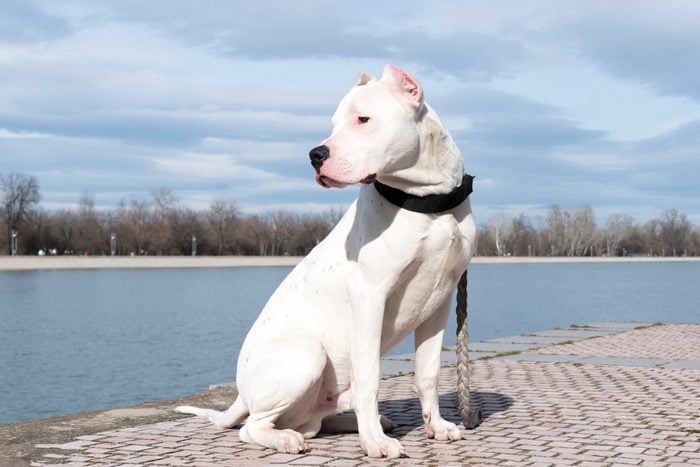
14. Dogo Argentino
Average cost: $3,000
In 2020, the AKC recognized the Dogo Argentino as an official breed. As a new-ish and cool dog on the block, it could be why it’s one of the most expensive dog breeds right now. As a working breed, it possesses vigilant guarding instincts and a strong tendency to protect its territory (you and your home). Yet, like most guard dog breeds, it is also lovable and super affectionate with its inner circle of humans. Because Dogo Argentinos were originally developed to hunt big game, those genes still run through their veins. They are serious athletes who crave daily physical and mental activity, especially games that utilize their keen sense of smell.
| Breed overview | |
| Height: | 24 to 26.5 inches |
| Weight: | 80 to 100 pounds |
| Life expectancy: | 9 to 15 years |
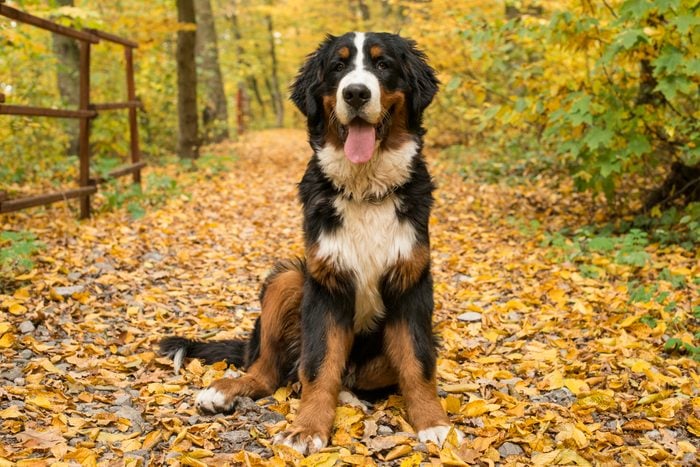
15. Bernese mountain dog
Average cost: $2,980
Large and in charge—of your heart—the Bernese mountain dog (aka Berner) is the big ball of love we can’t get enough of. Berners check off a lot of boxes for people looking for a large and affectionate dog, so it’s easy to see why they are one of the most expensive dogs.
At the top of the list of attributes is versatility. The Berner can jet through an agility course, pull the kids on a sled and watch over your family and home. And home is where the Berner’s heart is. They thrive on family togetherness, and even though they are big dogs, they are generally a quiet dog breed that doesn’t bark too much and are gentle around kids.
| Breed overview | |
| Height: | 23 to 27.5 inches |
| Weight: | 70 to 115 pounds |
| Life expectancy: | 7 to 10 years |
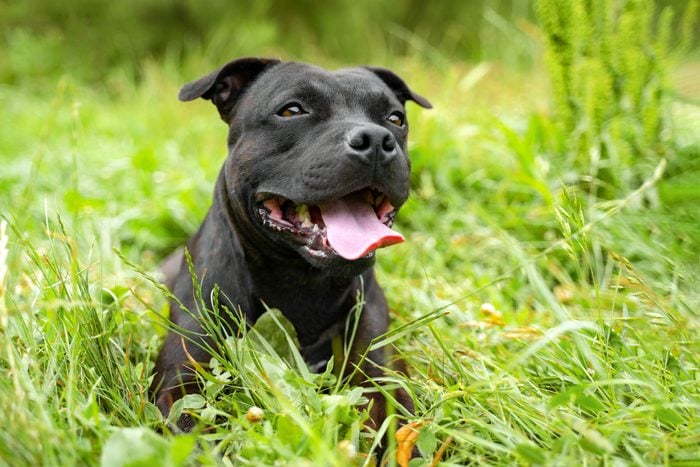
16. Staffordshire bull terrier
Average cost: $2,900
Today, the Staffie is more popular than ever as a lovey-dovey, sweet-natured dog, but sadly, they were initially bred for fighting. Dr. Coble says those instincts can still be present, so as with any breed of puppy, they should be carefully socialized with other dogs and people.
They hold their families in high regard and keep a close eye on family members and their property, so it’s perfectly natural that they would be a little suspicious of strangers. Yet, they are deemed aggressive breeds by some locals and actually outlawed. Pet parents may be required to build kennels and install fences or pay higher premiums for liability insurance. “These are not reasons to abandon the breed altogether,” says Dr. Coble. “Just make sure they are allowed where you are living prior to purchase, and invest in good training and socialization.”
| Breed overview | |
| Height: | 14 to 16 inches |
| Weight: | 24 to 38 pounds |
| Life expectancy: | 12 to 14 years |
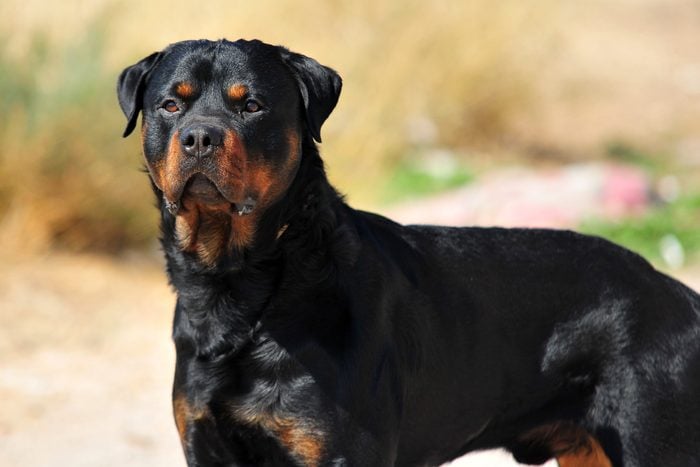
17. Rottweiler
Average cost: $2,750
Rottweilers were initially developed to guard, drive and hold cattle. They even guarded the cattlemen’s money by wearing the cash in a pouch around their neck. They’re still thought of as guard dogs, but instead of cattle, they’re used by police and the military. However, they can be good pets for families with early and consistent training and socialization.
Rotties are sharp, tireless and eager to learn new skills. They are a powerful German dog breed that is confident, bold and a bit intimidating to someone who doesn’t know them. But to their family, Rotties are fun-loving, uber-affectionate and often comical.
| Breed overview | |
| Height: | 22 to 27 inches |
| Weight: | 80 to 135 pounds |
| Life expectancy: | 9 to 10 years |
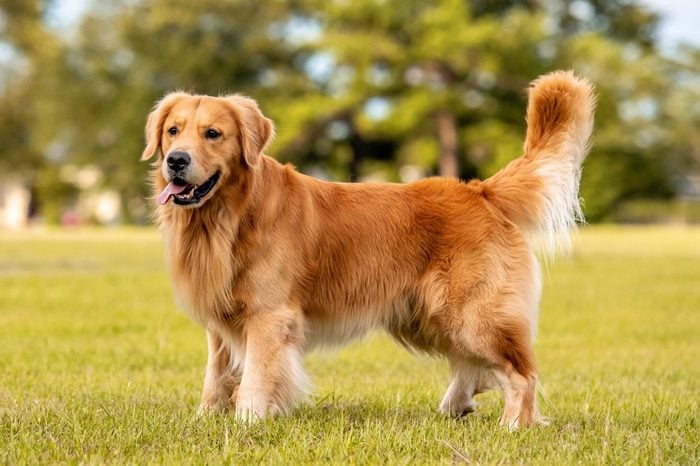
18. Golden retriever
Average cost: $2,750
Who would have thought that a Scottish gun dog would be one of the most popular dog breeds in America? “Me,” the golden would answer. An impressive jack-of-all-trades kind of dog, the golden can be a therapy or service dog, a standout candidate in competitive and obedience events or an outdoor sports partner in hunting and field work. And we haven’t even mentioned the good-natured, loving, eager-to-please and loyal characteristics yet. Wrap up all those qualities and you have a dog that is pretty close to perfection—and likely warrants a higher price tag.
| Breed overview | |
| Height: | 21.5 to 24 inches |
| Weight: | 55 to 75 pounds |
| Life expectancy: | 10 to 12 years |
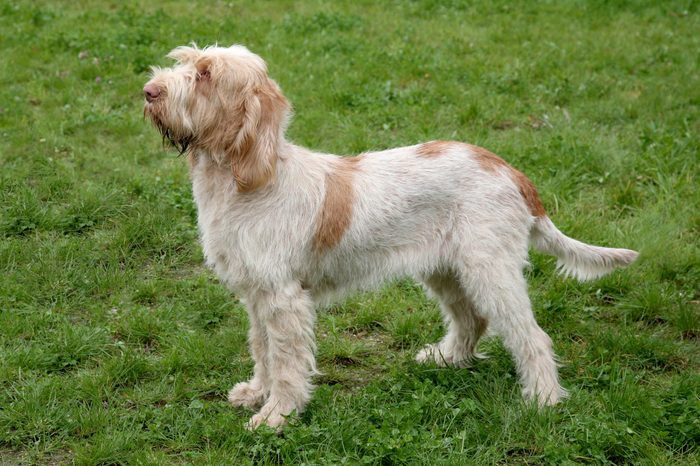
19. Spinone Italiano
Average cost: $2,630
Italian dog breeds like the Spinone Italiano have a reputation for sharp intelligence and impressive speed and endurance in field hunting. But it just may be their stylish good looks that point to their expensive dog breed price tag. Their soft and furry pendulous ears and sweet expressive eyes are enough to melt anyone’s heart—not to mention their distinguished beards and shaggy eyebrows. Besides being irresistibly cute, they are highly trainable, notably sweet and affectionate with their family, and they socialize well with other dogs.
| Breed overview | |
| Height: | 22 to 27 inches |
| Weight: | 65 to 85 pounds |
| Life expectancy: | 10 to 12 years |
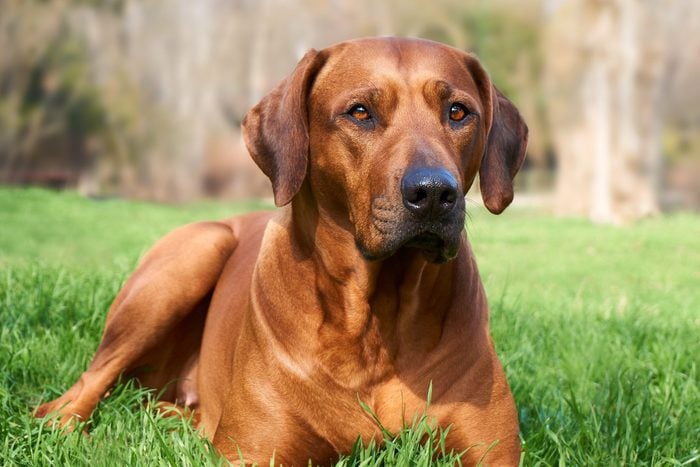
20. Rhodesian ridgeback
Average cost: $2,600
These graceful and devoted caretakers were bred with wild African dogs—that’s how they got their distinctive stripe of hair that grows in the opposite direction along their spine (the ridge). “They are loyal friends with stern personalities,” says Dr. Kishore. “The once lion-hunting dog breed may not be the best choice for a new dog owner.”
Because they can be strong-willed and independent, an experienced dog parent dedicated to providing early socialization and consistent training is essential for them to be good options for families. Then they’re loving and protective of their family members and especially protective of younger children. As one of the most expensive dog breeds, they are well worth the price tag for their companionship and guarding nature.
| Breed overview | |
| Height: | 24 to 27 inches |
| Weight: | 70 to 85 pounds |
| Life expectancy: | 10 to 12 years |
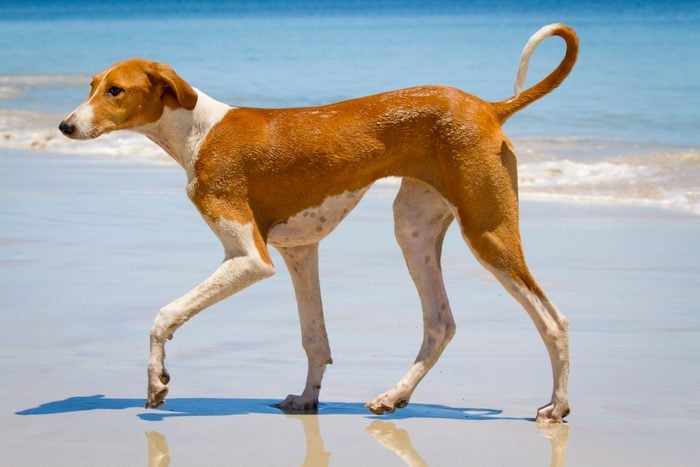
21. Azawakh
Average cost: $2,500
With a resemblance to a greyhound, this unique long-nosed dog breed is ultra-lean and uniquely elegant. At first glance, the Azawakh looks like it missed a few meals, but this leggy and slim breed was well-suited for chasing gazelles in the sands of the Sahara for more than 1,000 years. Their need for speed hasn’t changed. “They require a large running area to meet their desire to sprint,” says Dr. Kishore.
They’re highly intelligent, fairly independent and reserved with people they don’t know, so don’t delay your puppy training. However, when they’re around their humans, they are deeply affectionate. And here’s a bonus: Azawakhs are one of the dogs least likely to drool, and they don’t have a “dog odor”—attributes fitting for a posh, regal and pricey breed.
| Breed overview | |
| Height: | 23.5 to 29 inches |
| Weight: | 33 to 35 pounds |
| Life expectancy: | 10 to 15 years |
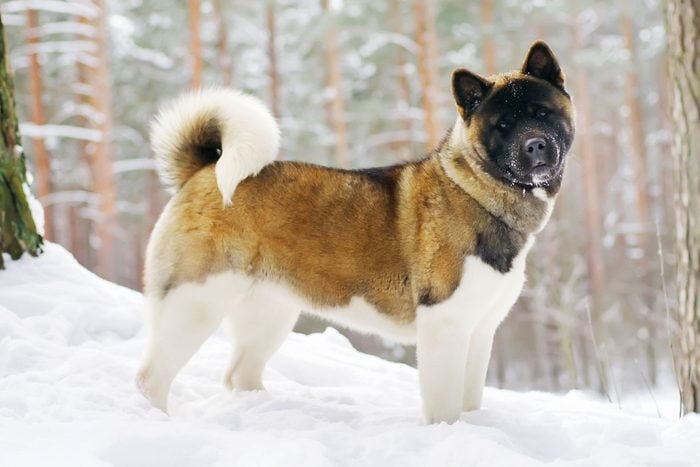
22. Akita
Average cost: $2,300
Before Akitas had an official breed name, they were referred to simply as “snow country dogs.” Their dense undercoat, raised outer layer of fur and webbing between their toes served them well while hunting in the snowy mountains of Japan. Nowadays, these authentic Japanese dog breeds are better known for being devoted watchdogs and protectors, but they still prefer the cold over hot temperatures.
Akitas love the snow so much, in fact, that they’ll be the first one out the door when the white stuff piles up. They love to play and roll around in it. They have a tendency to be domineering and aren’t crazy about other dogs or pets; they’re also reserved with strangers. Still, with the right person or family, they make lovable companions.
| Breed overview | |
| Height: | 24 to 28 inches |
| Weight: | 70 to 130 pounds |
| Life expectancy: | 10 to 14 years |

23. Saint Bernard
Average cost: $2,300
If you find yourself flocking to parks and trails to take in the fresh air and calming scenery—and you’d like to share those calming vibes with a big rugged mountain dog breed that loves adventure—your search may be over. This super chill giant of the Swiss Alps was famous for rescuing travelers trapped in the snow and avalanches back in the day, and while it still can step up to that role, Saint Bernards are content to be non-working members of the family due to their calm demeanor and lower exercise requirements.
They often come from conformation show dog breeders, hence the higher price tag. And you’ll want to save some cash for vet bills. “Their predisposition to hip dysplasia, elbow dysplasia and bloat come with expensive veterinary bills,” says Dr. Kishore.
| Breed overview | |
| Height: | 26 to 30 inches |
| Weight: | 120 to 180 pounds |
| Life expectancy: | 8 to 10 years |
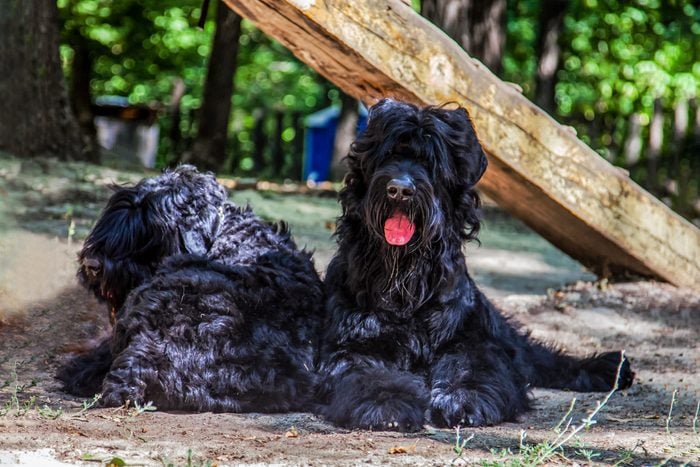
24. Black Russian terrier
Average cost: $2,250
We typically think of terriers as small and cute wiry dogs, but the Black Russian terrier is an exception. When all four paws are on the scales, it can weigh as much as 140 pounds and stand 30 inches tall at the shoulder. It’s indeed a muscular and powerful dog, well-suited for guarding and protecting. Like other giant dog breeds that make great pets, they are eager to please and wicked smart, but unlike other big dogs, they’re not loafers and need plenty of exercise and mental stimulation to keep them happy and out of mischief.
| Breed overview | |
| Height: | 26 to 30 inches |
| Weight: | 80 to 130 pounds |
| Life expectancy: | 10 to 12 years |
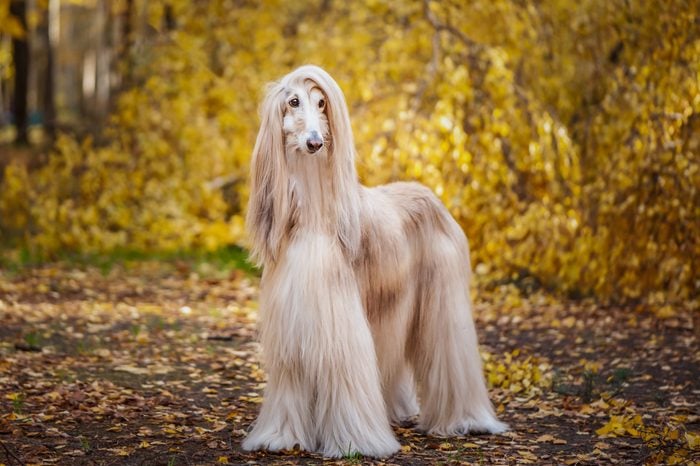
25. Afghan hound
Average cost: $2,250
When it comes to long-haired dogs with gorgeous locks, the Afghan hound is the supermodel of the canine runway. But their regal and dignified appearances aren’t without loads of maintenance—and money. If you love to dote on your fur baby, this may be the breed for you. Regular brushing and weekly baths are essential to maintain those silky locks.
Independent, self-confident and a bit strong-willed, Afghan hounds can be challenging to train. Yet, they are also incredibly sweet and clownish at times. They may give off a pretentious vibe and be aloof with strangers, but they’re generally affectionate with their own family.
| Breed overview | |
| Height: | 25 to 27 inches |
| Weight: | 50 to 60 pounds |
| Life expectancy: | 12 to 18 years |
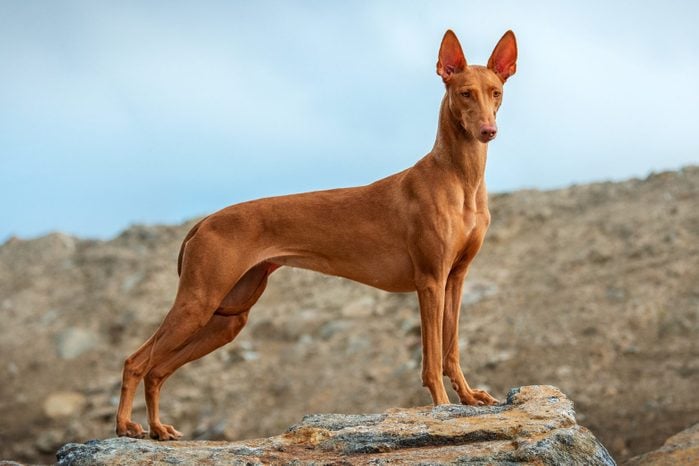
26. Pharaoh hound
Average cost: $2,250
The Pharaoh hound hails from Malta and is known for “blushing” when happy or excited. This quirky natural phenomenon occurs when the nose and ears flush with blood. When they are deliriously happy (anticipating a tasty treat or just excited to see you), they’ll shake their whole body and open their mouth so big you could do a dental exam.
Although it is the national dog of Malta and bears a striking resemblance to the jackal god Anubis from ancient Egypt, it is one of those rare dog breeds you probably didn’t know about—and might have a hard time finding. But the people who do have Pharaoh hounds know they are gentle and loving and have high energy levels. “Their lean bodies are built for exercise, so make sure you fit in at least two 30-minute walks per day,” says Dr. Coble.
| Breed overview | |
| Height: | 21 to 25 inches |
| Weight: | 45 to 55 pounds |
| Life expectancy: | 12 to 14 years |
Why trust us
At Reader’s Digest, we’re committed to producing high-quality content by writers with expertise and experience in their field in consultation with relevant, qualified experts. For this piece on the most expensive dog breeds, Lisa Marie Conklin tapped her experience as a reporter who has covered dogs and pets for seven years, and then Caroline Coile, PhD, an award-winning journalist specializing in canine breeds, health and science, gave it a rigorous review to ensure that all information is accurate and offers the best possible advice to readers. For this piece, we relied on reputable primary sources and experts. We verified all facts and data and backed them with credible sourcing, and we will revisit them over time to ensure they remain accurate and up to date. Read more about our team, our contributors and our editorial policies.
Sources:
- Jaclyn Coble, DVM, veterinarian at Sea Legs Integrative Veterinary Health in West Roxbury, Massachusetts; email interview, Jan. 29, 2024
- Deepan Kishore, DVM, veterinarian at Neel Veterinary Hospital in Oklahoma City, Oklahoma; email interview, Jan. 31, 2024
- CBS News: “Tibetan Mastiff, “Big Splash,” sells for $1.5 million, world’s most expensive dog”
- Hill’s Pet: “Dog Breeds”
- Gooddog.com: Pricing

